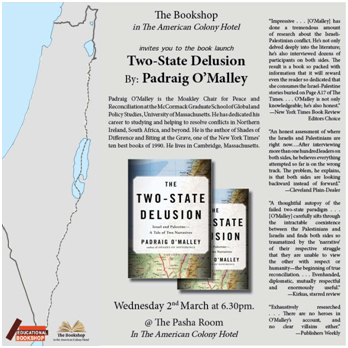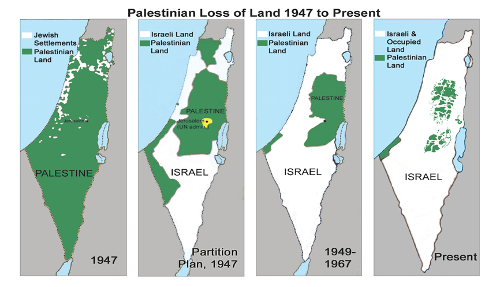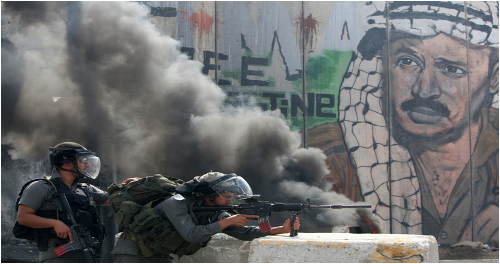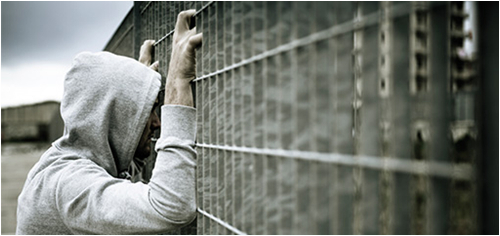
Haaretz’ diplomatic correspondent Barak Ravid (March 8 2016) described the intention of President Barack Obama to renew a Palestine-Israel peace process before the end of his term as follows:
- “It would serve as a new source of authority for the peace process, secure and preserve the two-state solution, and make it clear to the Israelis and Palestinians what concessions they would have to make if they one day decide to renew the peace process.“
A Parallel State Solution, Two People for One Land: A Controversial View of the Situation
On the 2nd of March 2016, an overflowing audience attended the American Colony Bookshop conference. The conference was devoted to Professor Padraig O’Malley’s book presentation, entitled “The Two-State Delusion.” This title advocates by itself the complex subject addressed as the author aimed to show the lack of sense in enforcing a Two-State Solution within the present political circumstances. There appears to be less and less probability to reach this goal.
At a time where people are putting the little hope they have left in the only solution that seems to have a broad consensus; the writer gives another view of the situation, picturing it as a dead end. He describes it as a reassuring perspective for the future, good enough for political debates but impossible to implement in a concrete way. This statement as appears to be a hope killer for a majority of the audience who, like many, seemed to have put a great deal of effort to support a two-state outcome.
While Israelis and Palestinians are trying to find a solution to cohabitate as neighbors in a non-violent surrounding, there appears to be no political springboard to open to a sustainable path for peace.
A brief presentation of the situation’s limits to advance further
The authorities on the Palestinian and on the Israeli side have apparently not changed their basic approaches to solving the conflict since 1948. The Israelis did put new ideas on the table, but failed to change their mentality during the negotiations with the PLO and later on with the Palestinian Authority (PA).
It is important to clarify that the PA (which is an offspring of the PLO, Palestine Liberation Organization), was first intended to be a provisory institution while Israel would little by little withdraw from the Palestinian Occupied Territories called areas C and to a lesser extent B; allowing the Palestinian State to become progressively independent as it is in Area A. The A, B, C Areas statute is a prescription for different degrees of control of Israel on Palestine since the 1995 Oslo II accords.

The second barrier was the lack of disposability of Israel towards Hamas. According to the Prof. O’Malley, the party, viewed, as a threat to many Israelis should be considered as a diplomatic interlocutor, granting them political responsibilities within the country. There will be no solution without open dialogue with the winner of the last Palestinian elections in 2006. This is very difficult for Israel to even consider as a possibility. Consequently, one of the main requirements would necessarily compel Hamas to hand in their weapons. Nevertheless, there is no guaranty President Abbas could take the responsibility and succeed in enforcing such a venture. “This factor eradicates by itself the Two-State solution.“
The lack of uniformity in the authorities’ decision-making
There is a great disparity dividing the political visions on both sides. On the one hand, on the Israeli government’s side, there are three different teams working on the peace process each one with very different opinions on the scheme to be followed; and on the other hand, by the Palestinians, Hamas like Fatah have more or less five different groups, showing a great lack of homogeneity between them. This shows the complexity of the situation, making it even more chaotic than it appears at first.
A few words on the Professor O’Malley’s background
Professor Padraig O'Malley was born in Dublin, Ireland, in 1942. He is a peacemaker, noted author and professor at the University of Massachusetts, Boston, who specializes in the problems of divided societies, such as South Africa and Northern Ireland. He has written extensively on these subjects and has been actively involved in promoting dialogue among representatives of differing factions. The links that have been made between the distinct situations is first and foremost the need to deal in depth at the roots of the issue. In order to reach the criteria needed to come to a long-term resolution, these delicate matters reside as much in the fact of coming to an agreement, than in the way they will be handled. To enable progress it is first necessary to comprehend the concessions that are to be made in such a process and to resist the temptation to deal with them in a superficial way.
What is at stake?
The most prominent desire of the Palestinian People is of course to restore their dignity, which has been taken away from them since 1948, enabling the end of the state of humiliation they have been in for so long. They ask to be given the right to govern their own state within clearly defined borders.
Would a Two-State Solution allow these desires to become true? Or is it simply a utopian response to a far more complex problem and to the despair it generates for generations?
A lack of Leadership
Another obstacle to the Two-State solution is the lack of apparent political will among the younger generations. On both sides of the conflict, there does not seem to be a view of leadership defined to lift up spirits and show a new side of the events through hope.

The main problem remains…“We cannot trust them!“
All of these factors unfortunately an underlying profound trust issue not only amongst both parties of the conflict, but also intra generations and political aspirations. According to Professor O’Malley, whether it is justified or not, this will have to change radically in order to have a new wave of hope in the current circumstances as. Prime Minister Netanyahu recently said that the Israeli Nation was on its own, as it cannot trust even its best allies, the United States. This statement shows a type of auto defense mechanism causing Israel to go against any type of dependence towards others with the aim to survive. It is a sign of fear that translates into a demand for ever more security and strength. Whether this reaction of paranoia, usually due to a post-traumatic stress syndrome, is real or imagined it is certainly a feeling that is not always controllable and that is expanding to a whole community of people for generations. One thing is certain, if these two people continue to consider each other as victims of the situation, they will never be able to overcome their traumatic life conditions, as they will keep on being prisoners of their own fates.
On the religious aspect of the conflict
The problem continues to grow as Israel becomes more and more religiously inclined. The speaker underlined the fact that this does not help people from different cultural backgrounds within the country to adapt to each other. In fact, the radicalization of the society makes it difficult to interact in a normal political and social environment. There seems to be a correlation between that previous phenomenon and the strong discrimination that exists against Palestinians, or so-called Arab Israelis. The most relevant case is seen in the differences within the two populations’ civil rights.
Changing the Status Quo
One of the most predominant issues, often condemned by the international community, is found within the context of settlements, not only in the perspective of Human Rights and of the 1949 UN Armistice Agreement, but also in the practical issues linked to territories and population growth. There doesn’t seem to be any way these settlements may be evacuated from the Palestinian Occupied Territories. Imagining the IDF soldiers evacuating their own citizens from those zones appears to be highly improbable. We can add to this the factor that the Israeli army increasingly recruiting people from settler’s background, is ideologically moving closer to the religious authorities than to the governmental ones. Therefore, the Prime Minister has no other choice than to stick to the status quo if he wants to keep control of his people. He might be fearful of the consequences a change in the Occupied Territories could cause on the political structure. Thus it would be very difficult to get rid of settlements and consequently to have a sovereign Palestinian state.
What about the refugees?
They are not to be forgotten. The difficulty here is that many fear a new type of radicalization coming from Jordan, as there is strong evidence of the presence of ISIS in the country. Opening the borders to the Palestinian territories could immensely weaken the Jewish State.
According to an article appeared in Haaretz on the 9th of March 2016, 30% of the Palestinian people say that they want the refugees to come back to their land and to their homes, while nearly half of the Israeli population thinks it would be preferable to send away all Palestinians from the Israeli controlled territories.
What is to be done with the 60% of Palestinians who had to flee after the 1948 war?
If there were to be a Palestinian State in the near future, what would it look like?
The Palestinian State is half secular, half Islamic. As an example of independent Palestinian State, the economy in Gaza is not doing well, and the two main political parties might find themselves in a civil war hating each other even more than they hate Israel.

For all of the above reasons, from a realistic point of view, most specialists who support a Two-State Solution have found themselves becoming, throughout their research, becoming more inclined to a confederation scheme, which reduces many of the current obstacles. Thus Prof. O’Malley believes that to end the misfortune of the people of this land, it is rather a question of going for the lesser bad option than for the ideal one. He believes that a concrete alternative to this could be the Parallel State Solution, enabling free movement on the territory within Palestinian and Israeli Law. The idea of having one land for two people could solve a lot of problems, including the one major issue related to settlements.
The aim of Prof. O’Malley did not appear to be to criticize or victimize one side or the other, rather to challenge the critical thinking of all. This conference was a clear call for change. In the same sphere of thought as Professor Scott A. Bollens (See http://www.pij.org/details.php?blog=1&id=376), Professor O’Malley’s approach is to compare the different schemes of inter-cultural conflict situations in perspective to present an alternative vision in order to become more autonomous and less prisoner of the mentalities that keep people enslaved in these contexts.
The Israeli-Palestinian conflict is a particular case, but the human schemes stay the same and, considering the religious, political and human constraints linked to this land, one can only try to face this situation in the hope of a near end of the sufferings.
Many thanks to the American Colony Bookshop for hosting such prominent specialists and interesting topics, pushing always further the intellectual debates and reasoning on these ever more present and difficult issues.
